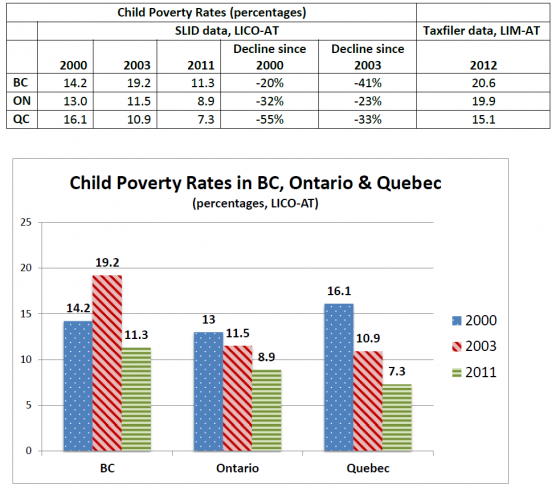Dear Premier Clark and Minister Cadieux,
Thank you for your response to our 2014 BC Child Poverty Report Card dated December 22, 2014. We decided to write this response as an open letter, as many of the points made in your correspondence are being repeated by government spokespeople in the media and we want to give people hearing them a full understanding of the credibility of our research.
First of all, we are glad to hear that your government believes that one child living in poverty is one child too many. We agree wholeheartedly.
Given this belief, we are puzzled by other aspects of your response. BC is about to introduce a budget with a surplus. In this context, and recalling BC’s obligations as a signatory to the United Nations Convention on the Rights of the Child (UNCRC) to make the best interests of children a priority, including their right to the enjoyment of the highest attainable standard of health, your argument that BC has a good track record on child poverty stands in stark contrast to the numbers: 169,420 children (1 in 5) in this province live in poverty according to the most recent statistics (2012). For children living in lone-parent families, a shocking 1 in 2 are poor.
We have heard government spokespeople dispute the accuracy of the statistics in the First Call Report Card. These statistics come from Statistics Canada. They are drawn from actual taxfiler income data and the measure of poverty used, the after-tax Low Income Measure (LIM-AT) is used by provinces across Canada, e.g. Ontario, and is widely used internationally. If anything, the LIM-AT poverty lines (by family size) are a conservative measure, as they do not take into account the high cost of living in many parts of BC compared to other provinces and cities.
These statistics call for urgent response, rather than a defense of the status quo. In the Report Card we propose nineteen recommendations, fourteen of which fall within provincial jurisdiction, which would improve children’s lives if government acted on them. First Call has been calling for many of these recommendations for years, and they have been echoed by the Select Standing Committee on Finance and Government Services in their reports on provincial budget consultations.
Our primary recommendation for a legislated provincial poverty reduction plan is dismissed in your letter because other provinces’ plans have demonstrated “inconclusive” success. This defeatist stance assumes BC cannot put a good plan in place. Poverty reduction plans are mechanisms for accountability for tracking and measuring progress, or the lack of it, in relation to specific targets and timelines. A plan is only as good as the evidence base on which it rests and the commitment or political will behind it. Government ministries all have service plans with annual performance goals to be measured. Low income children and families deserve the same level of attention to outcomes and the same rigor in measuring progress to reduce their poverty.
You assert that BC has done better at reducing child poverty than Quebec and Ontario, two provinces with legislated plans. We have looked at the trend data in the three provinces from 2000 to 2011, as illustrated in the following chart and graph. Over this period, BC has the smallest decline in child poverty rates of the three provinces and the highest rate in 2011. As shown in the chart, cherry-picking 2003 as the benchmark year, masks the dramatic jump in BC’s child poverty rate from 2001 to 2003 and gives a false impression of your government’s track record. Our new data from 2012 also shows Quebec and Ontario doing better than BC. We still have lessons we might learn from other provinces.
In your letter you state that government believes there are two ways to address poverty, with creating jobs and a strong economy being the first. You did not offer any measures of how BC’s job creation efforts are doing in reducing child poverty. We agree that well-paying, secure jobs with benefits can be key to reducing the depth and incidence of child poverty. Our tracking of child poverty statistics over the years indicates that the majority of BC’s poor children live with parents who have jobs, but they are still poor. In 2012 43% of BC’s income earners made less than $25,000 per year. Low wages and precarious work are major factors in high levels of child poverty in the province. This is why several of our recommendations point to the need to make sure parents’ wages are sufficient to lift their families out of poverty.
You point to a list of targeted supports as the second way BC is addressing the issue of poverty. Again, we agree that reducing the costs of essential services and living expenses for families is an effective way to reduce poverty levels, as are income supports for those who are unable to work or unable to secure work. Many of our recommendations suggest improvements to these targeted supports to make them more effective, such as raising social assistance rates and addressing the child care crisis for families.
We were certainly pleased to see BC’s minimum wage raised to $10.25 in May 2012. However, it is now 2015 and BC was the only province that did not raise its minimum wage in 2014. A single parent with one child working full-time, full-year at minimum wage would have been $8,000 below the 2012 poverty line. Two parents both working full-time, full-year at minimum wage with two children would have been $990 below the poverty line. Meanwhile, the BC consumer price index rose by 1.2% between November 2013 and November 2014, which means the lowest waged workers continue to fall behind in their buying power. We recommend raising the minimum wage to $15 per hour as soon as possible, and indexing it annually.
With regard to your reference to BC’s low personal income tax rates, we note that poor families pay little or no income tax and yet are still poor. Overall tax cuts, rather than being a gift to poor families have reduced government’s ability to provide those targeted supports and services low income families and children need.
Child care subsidy eligibility thresholds have not been adjusted for many years and subsidy rates have been stagnant for almost a decade, and have certainly not kept pace with the skyrocketing cost of child care fees. You mention that BC paid $135 million in subsidies this year. This is less than the $154 million in subsidies paid in 2011. Research evidence indicates that subsidies are not the best way to support accessibility to quality child care and we draw your attention to our recommendation to adopt and begin implementing the proposed $10 a day child care plan.
With regard to the 800,000 British Columbians who receive MSP premium waivers, this is because their annual incomes are below $22,000 per year. If these families have children, they are living in poverty. Premium assistance eligibility thresholds were last adjusted January 1, 2010, while premium rates have been increasing steadily year over year. Many lower income families just above the premium assistance cut off of $30,000 per year are being squeezed by these ever higher premium costs. BC is the only province that charges these health care premiums.
You also reference government’s investments in affordable housing and social housing. A recent study by the Canadian Centre for Policy Alternatives showed virtually no growth in social housing stock for poor families between 2006 and 2013. Wait lists remain very long.
We appreciate the Rental Assistance Program which subsidizes market rentals for employed families with children if their income is $35,000 per year or less. However, subsidy amounts are a small portion of actual rents, e.g. a Metro Vancouver family of 4 earning $24,000 per year (or $2000 gross per month) would qualify for a maximum rental subsidy of $349/mo. By comparison, the Metro Vancouver Living Wage rent calculation for this family size is $1300 per month. In today’s rental market, many more families could use help with their rent costs if the eligibility criteria were broadened. Families trying to find appropriate shelter on income assistance rates are terribly disadvantaged in this market.
You state in your letter that in light of your government’s commitment to maintain a balanced budget, substantial investments such as raising income assistance rates or implementing the $10 per day child care plan are “not feasible in our current economic climate.” With all due respect, we have been hearing this argument from government for over a decade, even when the economy was strong (pre-recession) and budget surpluses were posted. The choice not to invest in significant measures that will reduce child and family poverty is not prudent, as it ignores the actual costs of maintaining high poverty levels in BC.
This choice also does not respect children’s rights as outlined in the UNCRC. (See selected list of articles appended at the end of this letter.) The biggest spending choice government has made is decreasing provincial revenue by lowering tax rates for profitable corporations and higher income earners.
We are asking you to put child poverty reduction efforts at the top of the list of priorities that merit substantial investments.
With regard to government’s commitment to cross-ministry collaboration and work with local communities to find innovative ways for addressing poverty, we have watched this approach as implemented in the seven local provincial poverty reduction initiatives. These were intended to be pilots to learn from and scale up, but they have no measures of poverty reduction attached to them and, not unexpectedly, have not reduced poverty levels in those communities. Asking local communities, public services and social service organizations to reduce poverty with no changes in policies that trap people in poverty and no additional resources to support their efforts has predictably accomplished little. Only policy changes and investments at the federal and provincial levels will have the necessary weight to address the large scale and scope of the child poverty crisis in BC.
Through the recommendations in our Report Card, we ask government again to look to the areas of policy in your control and take bold and significant action to invest in evidence-based policy reforms and services that are known to reduce child and family poverty levels. We realize policy changes and larger investments need to be planned with care and implementation must be staged over time. We are asking you to listen to the growing chorus of stories of hardship resulting from the status quo, heed the negative trends showing up in health and early childhood vulnerability rates and move from denial to a focused action plan. There is tremendous public support for tackling this issue. We look forward to working with you to make BC a leader in reducing child and family poverty.
Sincerely,
Adrienne Montani
Provincial Coordinator
















